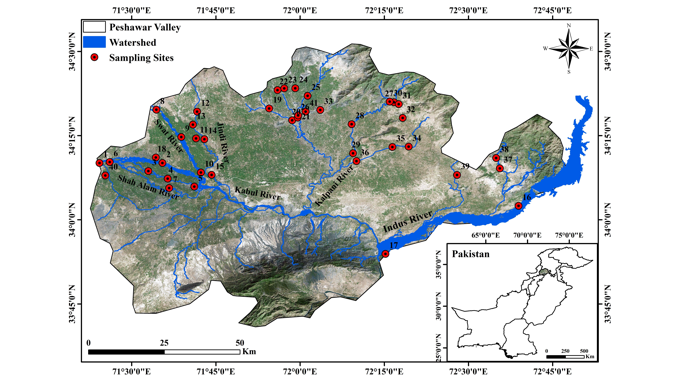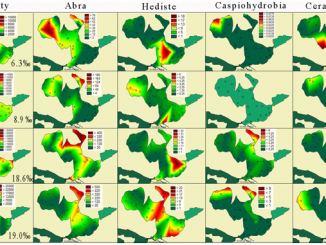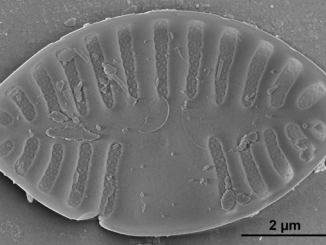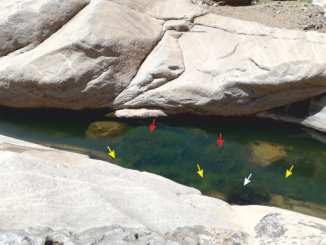
Paper category: Original research paper
Corresponding author: Sophia Barinova (barinova@research.haifa.ac.il)
DOI: 10.2478/oandhs-2021-0031
Received: 01/05/2021
Accepted: 02/06/2021
Full text: here
Citation (APA style): Khuram,I.,Ahmad,N. & Barinova,S.(2021).Effect of water quality on the spatial distribution of charophytes in the Peshawar Valley, Khyber Pakhtunkhwa, Pakistan. Oceanological and Hydrobiological Studies,50(4) 359-372. https://doi.org/10.2478/oandhs-2021-0031
Abstract
The presented research was conducted in 2018–2019 in the Peshawar Valley, Pakistan, to study for the first time the effect of water quality on the spatial distribution of charophytes. A total of six taxa of charophytes were found at 41 sites in the Peshawar Valley along the banks of seven rivers, 16 streams and two wetlands: Chara braunii C.C.Gmelin, C. connivens Salzmann ex A.Braun, C. contraria A.Braun ex Kützing, C. globularis Thuiller, C. vulgaris Linnaeus, and Nitellopsis obtusa (Desvaux) J.Groves. Chara vulgaris was the most abundant species, followed by C. globularis, and C. contraria. Water pH, electrical conductivity (EC), total dissolved solids (TDS), salinity and dissolved oxygen (DO) were within the permissible limits for Pakistan, while water temperature, oxidation reduction potential (ORP) and resistivity showed deviations. Canonical Correspondence Analysis (CCA) revealed that DO affected Chara vulgaris, pH and resistivity affected C. braunii, C. connivens and
C. globularis, temperature and ORP affected C. contraria and Nitellopsis obtusa. Furthermore, CCA showed that TDS, EC, and salinity had no effect on the spatial distribution of Chara contraria, C. vulgaris and Nitellopsis obtusa. Chara contraria and Nitellopsis obtusa should be protected under VU (Vulnerable) status (IUCN) along with their habitats.
Conclusion
Charophytes in the Peshawar Valley were represented by six species from the genera Chara and Nitellopsis, which were identified through the analysis of 126 samples collected from 41 sampling sites in 2018–2019. Ecological preferences of each species were revealed using different statistical programs. The similarity of accompanying algal species in terms of their abundance (Khuram et al. 2017, 2019) was also calculated to confirm the ecology of Charophyta at the study sites. Three pairs of species with similar responses to environmental parameters of water quality were identified. Chara braunii and C. connivens prefer low saline and low alkaline water and avoid polluted water, which allowed us to assign them to IUCN conservation status from LR to EN, as in Europe. Chara contraria and Nitellopsis obtusa avoid polluted waters and prefer low saline and low alkaline water with low temperature. The extinction risk for both species in the Peshawar Valley can be defined as VU and their habitats could be protected. The last pair, Chara vulgaris and C. globularis, tolerates pollution and prefers high salinity, high alkaline and well oxygenated water. Both species were found in heterogenous habitats of the Peshawar Valley and did not avoid polluted sites where the Swat and Kabul rivers enter the valley, so they do not need protection.
Acknowledgement
This work is part of the Ph.D. dissertation by Izaz Khuram.
References
Adhena, K., Estifanos, S., Hagos, M., & Abrha, B. (2020). Physico-chemical characterization of stream water in maichew area, southern Tigray, Ethiopia. GSJ 8(3).
Aisha, K. & Shameel, M. (1995). Some freshwater green algae near Balochistan coast of Pakistan. Pakistan Journal of Botany 27: 41–48.
Alam, M.M., Kudrat-E-Zahan, M., Rahman, M.H. & Zahid, A.M. (2020). Water Quality Assessment of Shitalakhya River. Asian Journal of Fisheries and Aquatic Research 9–20.
Al-Badaii, F., Shuhaimi-Othman, M. & Gasim, M.B. (2013). Water quality assessment of the Semenyih river, Selangor, Malaysia. Journal of Chemistry. DOI: 10.1155/2013/871056.
Ali, Z., Ahmad, S.S., Akhtar, M., Khan, M.A., & Khan, M.N. (2007). Ecology and diversity of planktons in lakes of Uchalli wetlands complex, Pakistan. The Journal of Animal and Plant Sciences 17: 41–42.
Barinova, S. (2017). Ecological mapping in application to aquatic ecosystems bioindication: Problems and methods. International Journal of Environmental Sciences & Natural Resources 3(2): 1–7.
Barinova, S., Ali, N., Barkatullah & Sarim, F.M. (2013). Ecological adaptation to altitude of algal communities in the Swat Valley (Hindu Cush Mountains, Pakistan). Expert Opinion on Environmental Biology 2(2): 1–15.
Barinova, S., Khuram, I., Asadullah, A.N., Jan, S. & Shin, D.H. (2016). How water quality in the Kabul River, Pakistan, can be determined with algal bio-indication. Advance Studies in Biology 8(4): 151–171.
Becker R., Doege A., Schubert H., van de Weyer K. (2016). Bioindikation mit Characeen. In Arbeitsgruppe Characeen Deutschlands Lehrstuhl für Ökologie der UniversitätArmleuchteralgen. Springer Spektrum, Berlin, Heidelberg.
Blaženčić, J., Stevanović, B. & Blaženčić, Ž. (2006). Distribution and ecology of charophytes recorded. Cryptogamie Algologie 27(4): 311–322.
Blaženčić, J., Kashta, L., Vesić, A., Biberdžić V. & Stevanović, B. (2018). Charophytes (Charales) of lake Skadar/Shkodra: ecology and distribution. In The Skadar/Shkodra Lake Environment (pp: 169–202) Springer.
Blaženčić, J., Stevanović, B., Blaženčić, Ž. & Stevanović, V. (2006). Red Data List of Charophytes in the Balkans. Biodivers Conserv. 15: 3445–3457
Blindow, I. (1992). Decline of charophytes during eutrophication: comparison with angiosperms. Freshwater Biology 28(1): 9–14.
Blindow, I. (2000). Distribution of charophytes along the Swedish coast in relation to salinity and eutrophication. International Review of Hydrobiology: A Journal Covering all Aspects of Limnology and Marine Biology 85(5–6): 707–717.
Blindow, I. & Langangen, A. (1995). Lamprothamnium papulosum (Wallr.) J. Groves, a threatened charophyte in Scandinavia. Cryptogamie Algologie 16(1): 47–55.
Bolpagni, R., Bettoni, E., Bonomi, F., Bresciani, M., Caraffini, K. et al. (2013). Charophytes of the lake Garda (Northern Italy): a preliminary assessment of diversity and distribution. Journal of Limnology 72(2): 31.
Bornette, G. & Arens, M.F. (2002). Charophyte communities in cut-off river channels: the role of connectivity. Aquatic Botany 73(2): 149–162.
Boszke, P. & Bociąg, K. (2008). Morphological variation of oospores in the population of Chara rudis A. Braun in a mesotrophic lake. Polish Journal of Ecology 56(1): 139–147.
Caisova, L. & Gąbka, M. (2009). Charophytes (Characeae, Charophyta) in the Czech Republic: taxonomy, autecology and distribution. Fottea 9(1): 1–43.
Dąmbska, I. (1964). Charophyta-stoneworts. Freshwater flora of Poland. 13.
Domozych, D., Popper, Z.A. & Sorensen, I. (2016). Charophytes: evolutionary giants and emerging model organisms. Frontiers in Plant Science 7: 1470.
Edler, L., & Elbrächter, M. (2010). The Utermöhl method for quantitative phytoplankton analysis. Microscopic and molecular methods for quantitative phytoplankton analysis 110: 13–20.
Eriksson, B.K., Sandstrom, A., Isaus, M. Schreiber, H. & Karas, P. (2004). Effects of boating activities on aquatic vegetation in the Stockholm archipelago, Baltic Sea. Estuarine, Coastal and Shelf Science 61(2): 339–349.
Faridi, M. (1955). A contribution to the Charales of west Pakistan. Biologia 1(1): 70–81.
Faridi, M. (1956). A new species of Nitella from Pakistan. Biologia 2(1): 254–255.
Feist, M., Liu, J. & Tafforeau, P. (2005). New insights into Paleozoic charophyte morphology and phylogeny. American Journal of Botany 92(7): 1152–1160.
Gąbka, M., Owsianny, P.M. Burchardt, L. & Sobczyński, T. (2007). Habitat requirements of the Charetum intermediae phytocoenoses in lakes of western Poland. Biologia 62(6): 657–663.
Government of Pakistan (1998). Population census organization statistics division government of Pakistan. Islamabad Census Publication 68: 1–25.
Guiry, M.D. (2012). How many species of algae are there? Journal of Phycology 48(5): 1057–1063.
Guiry, M.D. & Guiry, G.M. (2021). AlgaeBase. World-wide electronic publication, National University of Ireland, Galway. https://www.algaebase.org; searched on 01 January 2021.
Haas, J.N. (1994). First identification key for charophyte oospores from central Europe. European Journal of Phycology 29(4): 227–235.
Helcom. (2013). Red List of Baltic Sea species in danger of becoming extinct. Baltic Marine Environment Protection Commission Proceedings 140: 1–106.
Horne, A.J. & Goldman, C.R. (1994). Limnology. McGraw-Hill New York.
IUCN. (2012): IUCN Red List Categories and Criteria: Version 3.1. Second edition. IUCN, Gland – Cambridge.
Khuram, I., Barinova, S., Ahmad, N., Ullah, A., Din, S.U. et al. (2017). Ecological assessment of water quality in the Kabul River, Pakistan, using statistical methods. Oceanological and Hydrobiological Studies 46(2): 140–153.
Khuram, I., Muhammad, Z., Ahmad, N., Ullah, R. & Barinova, S. (2019). Green and charophyte algae in bioindication of water quality of the shah alam river (District Peshawar, Pakistan). Transylvanian Review of Systematical and Ecological Research 21(1): 1–16.
Krause, W. (1981). Characeae as an indicator species of water quality. Limnologica Jena 13(2): 399–418.
Langangen, A. & Leghari, S. (2001). Some charophytes (Charales) from Pakistan. Studiea Botanica Hungarica 32: 63–85.
Mursaleen, S.S., Ali, L., Ahmad, N., Kuram, I. & Barinova, S.S. (2018a). Algal communities of the Mardan River in ecological assessment of water quality in district Mardan, Pakistan. MOJ Ecology & Environmental Sciences 3(2): 82–92.
Mursaleen, S., Shah, S.Z., Ali, L., Ahmad, N., Kuram, I. et al. (2018b). Bioindication of water quality by algal communities in the Mardan River, Pakistan. International Journal of Biology and Chemistry 11(1): 65–81.
Noedoost, F., Riahi, H., Sheidai, M. & Ahmadi, A. (2015). Distribution of Charophytes from Iran with three new records of Characeae (Charales, Chlorophyta). Cryptogamie Algologie 36(4): 389–405.
Pal, B.P., Kundu, B., Sandaralingagam, V. & Venkataraman, G. (1962). Charophyta. Indian Council of Agricultural Research New Delhi.
Palamar-Mordvintseva G.M. & Tsarenko P.M. (2004). Red list of Charales of the Ukraine. Inter. J. on Algae 6(4): 305–318. DOI: 10.1615/InterJAlgae.v6.i4.10.
Pełechata, A. & Pełechaty, M. (2010). The in-situ influence of Ceratophyllum demersum on a phytoplankton assemblage. Oceanological and Hydrobiological Studies 39(1): 95–101.
Pełechaty, M., Pukacz, A. & Pełechata, A. (2004). Diversity of micro-and macrophyte communities in the context of the habitat conditions of a meromictic lake on Lubuskie Lakeland. Limnological Review 4: 209–214.
Prescott, G.W. (1962). Algae of the Western Great Lakes Area. Wm. C. Brown Co., Dubuque, Iowa.
Pukacz, A. & Pełechaty, M. (2013). Spatial structure of vegetation in a small charophyte dominated lake. Biodiversity Research and Conservation 29(1): 97–104.
Romanov, R. (2009). Charophytes (Charales: Streptophyta) of the south of the west Siberian Plain. Rastitelnyi mir Aziatskoi Rossii 1: 19–30.
Romanov, R. & Kipriyanova, L. (2010). Charophyte species diversity and distribution on the south of the west-Siberian Plain. Charophytes 2(2): 72–86.
Romanov, R. & Barinova, S. (2012). The charophytes of Israel: historical and contemporary species richness, distribution, and ecology. Biodiversity Research and Conservation 25(1): 67–74.
Sarim, F. (1991). Further notes on the Charales of Pakistan. Pakistan Journal of Scientific and Industrial Research 34(9): 348–351.
Sarim, F. & Ayaz, M. (2000). Genes Chara from Malakand Division, NWFP, Pakistan. Pak. J. Pl. Sci. 6(1): 1–7.
Shepherd, V., Beilby, M. & Heslop, D. (1999). Ecophysiology of the hypotonic response in the salt‐tolerant charophyte alga Lamprothamnium papulosum. Plant, Cell & Environment 22(4): 333–346.
Sviridenko, B.F. & Sviridenko, T.V. (2003). Distribution and ecology and charophyta in the northern Kazakhstan. Acta Micropalaeontologica Sinica 21(1): 139–146.
Ter Braak, C.J. & Šmilauer, P. (2002). CANOCO reference manual and CanoDraw for Windows user's guide: software for canonical community ordination (version 4.5). Microcomputer Power Press, Ithaca NY, USA.
Torn, K., Kovtun-Kante, A. Herkul, K. Martin, G. & Maemets, H. (2015). Distribution and predictive occurrence model of charophytes in Estonian waters. Aquatic Botany 120: 142–149.
Torn, K., Martin, G. Kukk, H. & Trei, T. (2004). Distribution of charophyte species in Estonian coastal water (NE Baltic Sea). Scientia Marina 68(1): 129–136.
Urbaniak, J. & Gąbka, M. (2014). Polish Charophytes: an illustrated guide to identification. Wydawnictwo Uniwersytetu Przyrodniczego.
Vesić, A., Blaženčić, J. & Šinžar-Sekulić, J. (2016). Ecological preferences of charophytes in Serbia in relation to habitat type and other aquatic macrophytes. Plant Biosystems-An International Journal Dealing with all Aspects of Plant Biology 150(3): 490–500.
Wade, P. (1990). The colonisation of disturbed freshwater habitats by Characeae. Folia Geobotanica et Phytotaxonomica 25(3): 275–278.
Wetzel, R.G. (1983). Limnology. Saunders College Publishing, Philadelphia, PA.
Wood, R.D. & Imahori, K. (1959). Geographical distribution of Characeae. Bulletin of the Torrey Botanical Club 86(3): 172–183.
Wood, R.D. & Imahori, K. (1964). A revision of the Characeae: Monograph of the Characeae. Volume I. Cramer.
Wood, R.D. & Imahori, K. (1965). A Revision of the Characeae: Monograph of the Characeae. Volume II. Cramer.



